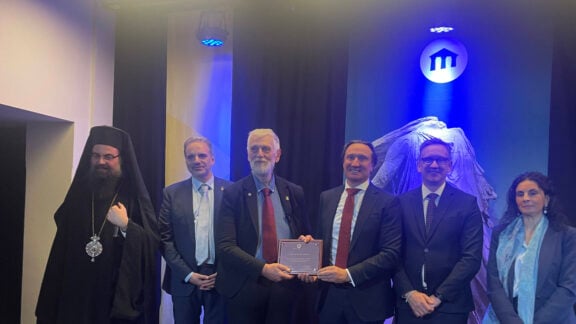As a response to post war era Australian shortages in heavy industry and agriculture, the Government signed agreements with European states as the country was eager for new immigrants to increase its population and labour workforce.
The people that arrived under those agreements were assisted and passed through immigration centres like Bonegilla which was situated around 300 kilometres north-east of Melbourne.
Bonegilla was originally an army training camp but in 1947 the Australian Government turned it into a Reception and Processing Centre run by the Department of Immigration.
From 1947 to 1971 it was a temporary home, a point of processing and dispersal to some 320,000 European post war refugees and migrants who came to Australia under assisted passage provided by the Government. As non-British assisted arrivals, they were all made to sign two-year work contracts with the Commonwealth in return for their assisted passage and temporary subsidised accommodation.
In her book Dr Alexandra Dellios writes that Bonegilla was viewed in a number of ways such as a detention centre; a little Europe; a concentration camp; the birthplace of multiculturalism; a place of no hope; an Eden and a first home.
Given that many migrant recollections are contested, Dellios told Neos Kosmos that finding the truth is difficult as it depends on who you talk to.
“Thinking of it from the perspective of a child, you were essentially camping, like a holiday,” she says.
“You had wide open spaces and you were completely unsupervised. Thinking of it from the perspective of an adult, you had no idea where you were going or what you were doing, you couldn’t speak the language and you had to raise children in an environment where there weren’t proper bedding or proper kitchens to cook your own food.”
While the majority of Greek migrants were sponsored and therefore not captured in the migrant camp net, there were still between 15,000- 30,000 Greeks that did pass through Bonegilla. Dellios tells says its role as a processing point didn’t always meet the expectations of those that passed through.
“The biggest shock for Greek migrants tended to be the food and the shock about the landscape. We’re talking about rural Victoria – a very barren landscape than what they were used to,” she says.
“The space of Bonegilla and its surrounds and even Albury the tiny country town were quite shocking. They came with the expectation that this would advance their family and their life and that this would be economically beneficial for them. They presumed that they were coming to a developed country, so being stuck in Bonegilla was a shock to many.”
Dellios also says that for those early Greeks the financial burden became a strain especially for those that took longer to find work.
“Often people accrued debt while they were at Bonegilla,” she says.
“If you repeatedly refused employment allocations you were denied unemployment benefits. It was very hard to save enough money to get out of that system.”
And it was the issue of work which was at the heart of one of the defining moments in Bonegilla’s history – the riots of 1952. Dellios’s book devotes a chapter to those events. In 1952, and again in 1961, Italian and other assisted migrants in centres and hostels across the country staged protests, demanding work or repatriation, as per their contract with the Government. This was in response to a lack of job opportunities and a feeling of desperation and being trapped in uncomfortable locations.
From a Greek perspective, the Democritus League, which was a leftist labour group for Greek workers, also participated in the protests on behalf of the Greeks in the camp demanding better conditions. Eventually the League was banned from entering Bonegilla in 1953 by the Department of Immigration.
“I managed to see a fair bit of their confiscated material in the archives. ASIO and the Department of Immigration kept tabs on this League” she says.
“They demanded that Greeks staying in Bonegilla should make it clear that they came to Australia for work not to get the unemployment allowances. That they should demand from the Government and from the Greek Consul to find them immediate work. The Department of Immigration classified them as promoting discord, but what they were really doing was letting Greek migrants know of their rights as migrants.”
When asked for the overall impression of the Greek experience at Bonegilla as a result of her research, Dellios points to some relative positives in terms of both time spent at the camp, as well as how Greeks were generally perceived.
“In the case of Greek migrants, a lot of them absconded from their work contracts,” she says.
“Most left Bonegilla with their families and used their personal connections or connections based on home villages to secure work in places like Melbourne and get away from the centre and hostel system.
“There was also a level of political acceptance when it came to Greek migrants, having come in from the right side of the wall. There was a level of pro- Hellenism when it came to ideas to do with democracy. So it made it easier for those groups within Bonegilla.”
Dellios added, “However refugees arriving from countries that were then Soviet ruled had experienced a certain amount of discrimination against them. But Greeks did not have that level of discrimination. Not that it wasn’t there, we’re still talking about a population that was overwhelmingly Anglo- Australian and which still upheld the White Australia Policy.
Dellios goes on to say that the politics of the Cold War had a lasting impact, including for eventual citizenship.
“Some of the groups that went out to visit Bonegilla migrants were considered to be communist sympathisers because of their left-wing politics,” she says.
“Many of those individuals like George Zangalis who I mention in my book was actually a member of the Communist Party of Australia and has talked openly about what a horrible place Bonegilla was. Many of those people were denied citizenship for decades up until the 1970s.
“I referenced some of his work in Neos Kosmos a few years ago, in which he called Bonegilla ‘a concentration camp’. He himself didn’t pass through the centre, but it was a common perception amongst many Greeks in Melbourne of what Bonegilla was and what it represented.”
Dellios’s grandparents migrated to Australia in the late 60s and were sponsored so didn’t pass through Bonegilla. But it was the experience of her parents that migrated to Australia as children that inspired her work in this field.
“I’ve always been interested in that generation of Greek migrants who arrived as children and grew up in Melbourne in the 70s,” she says.
“I’ve always been interested in issues of belonging and identity and multicultural spaces.
“So, when I started my history research I was interested in Greek child migrants. The space of Bonegilla is interesting because of what it represents for different groups. It had this aura that it was a place you escaped from, a place that you avoided. My grandparents remember hearing the word Bonegilla on the ship ride over to Australia. So, I just thought it was interesting because of its reputation. For Greek migrants at least, it was a place that you were told to avoid at all costs.”









